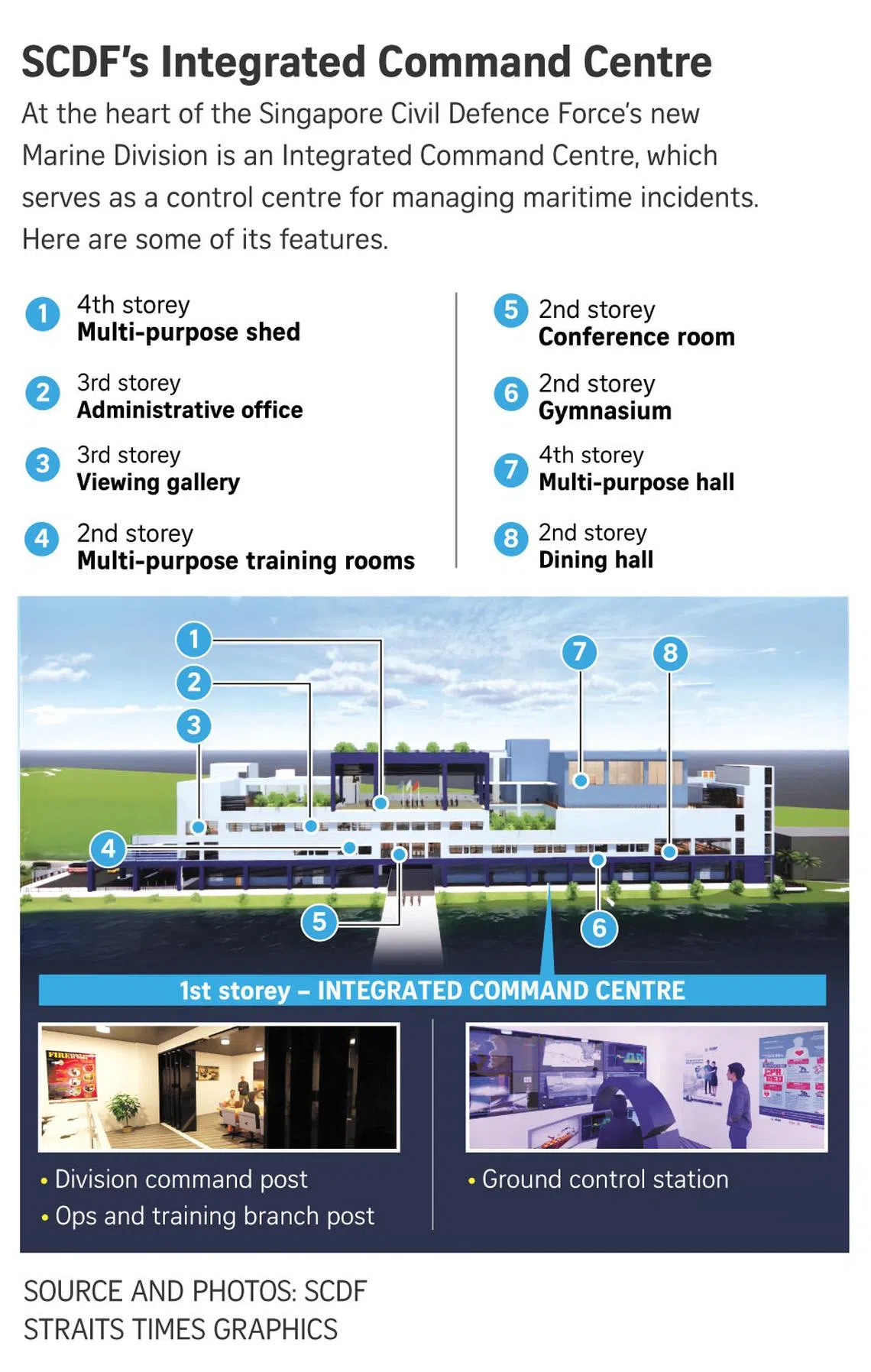SCDF’s Marine Division to get first stand-alone HQ by 2026 in boost to marine safety capabilities
Sign up now: Get ST's newsletters delivered to your inbox

A model of SCDF's planned Marine Division headquarters at the groundbreaking ceremony on Pulau Brani on Nov 15.
ST PHOTO: JASON QUAH
Follow topic:
SINGAPORE - By 2026, the Singapore Civil Defence Force’s (SCDF) Marine Division will have its first stand-alone headquarters, which will be built beside Brani Marine Fire Station, near HarbourFront.
The new headquarters will support SCDF’s increased operational responsibilities, and the training needs and administration of Marine Division officers.
This development was announced on Nov 15 in conjunction with the ground-breaking ceremony for the new headquarters, which is slated to be completed and operational in March 2026.
It comes as a new megaport will also be built in Tuas by 2040, nearly doubling Singapore’s handling capacity. Currently, more than 140,000 vessels call at Singapore’s ports every year.
By 2029, the division’s marine fire stations will have 10 firefighting vessels, up from the current six, which include the heavy fire vessel Red Sailfish –
And by 2035, the division will have six marine bases, up from the current four. Now, it boasts 220 active personnel, two fire stations (Brani Marine Fire Station and West Coast Marine Fire Station) and two fire posts (Loyang Marine Fire Post and Gul Marine Fire Post). The current Marine Division headquarters is co-located at the Brani station.
SCDF’s new vessels will feature dynamic positioning, a computer-controlled system that automatically maintains a vessel’s position and where it is headed during operations, increasing safety.
To complement the new firefighting vessels, SCDF has been developing an unmanned surface vessel (USV) that will facilitate smoother communication between teams during operations.
Assistant Commissioner Ryan Ong, commander of the Marine Division, said: “The new Marine Division headquarters, along with more deployment bases and vessels that will be built in the near future, will further bolster our coverage and allow us to manage multiple incidents simultaneously.”
SCDF’s Marine Division handles mainly marine fire and rescue incidents, be they on ships at sea, maritime accidents or missing people.
In 2024, as at October, it had responded to six marine fire incidents and 30 marine rescue incidents. In 2023, it responded to 11 marine fire incidents and 30 marine rescue incidents.
Since 2017, the Marine Division has also taken on an additional role handling marine chemical, biological and radiological incidents.
If needed, it also supports the Maritime and Port Authority of Singapore (MPA) in oil and chemical spill incidents.
In the aftermath of the June 14 oil spill at Pasir Panjang Terminal, SCDF deployed a rapid response fire vessel, used for firefighting operations, to support the cleaning of rock bunds at Siloso Beach from June 21.
On Oct 21, the Marine Division also supported MPA in responding to a fire that broke out on the Malta-flagged tanker Med Atlantic
According to SCDF, a water monitor from its marine rescue vessel was used to conduct defensive firefighting and cool the exterior of the vessel. “Once there were no visible signs of fire, marine firefighting specialists boarded the vessel with a water jet to ensure that the fire, which involved the vessel’s exhaust funnel, had been fully extinguished,” it added.
When the Marine Division was established in 2012
The new developments announced on Nov 15 mark a major milestone in enhancing Singapore’s maritime safety and response capabilities.
In his speech at the ground-breaking ceremony, Minister of State for Home Affairs Muhammad Faishal Ibrahim said: “The Marine Division of the future will be more capable – able to respond to emergencies in faster, smarter and safer ways.”

(From left) SCDF Commissioner Eric Yap, Minister of State for Home Affairs Muhammad Faishal Ibrahim and Assistant Commissioner Ryan Ong at the ground-breaking ceremony for the new headquarters on Nov 15.
ST PHOTO: JASON QUAH
At the heart of the new headquarters is an Integrated Command Centre (ICC), which will serve as a control centre for managing maritime incidents.
From there, officers can remotely pilot the USV and receive live video footage, which will be sent to other firefighting vessels at the site and the ICC. This would enable better situation awareness.
Equipped with communication systems integrating satellite and radio networks, the ICC allows for clear communication between commanders and on-the-ground teams.
The centre is also supplied with devices such as drones, body-worn cameras and ship-based sensors, which would provide commanders with a real-time overview of ongoing incidents, improving management of complex operations.

The headquarters will use advanced technologies to maximise operational efficiency and minimise human error, such as the “Smart Store” system, which can digitally track quantities of medical and operational supplies.
Additionally, the headquarters is designed to meet the Building and Construction Authority’s Green Mark Platinum sustainability standards, which is a rating system that evaluates a building’s ability to minimise environmental impact while optimising operational efficiency.
Solar panels installed on the rooftop will harness renewable energy, reducing reliance on traditional power sources. Low-flow fixtures will also be installed to reduce the use of drinking water.

